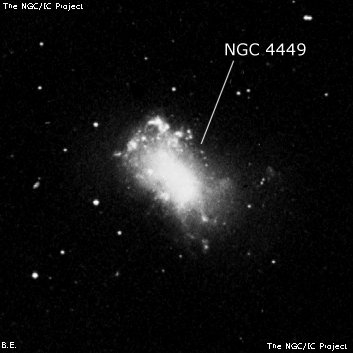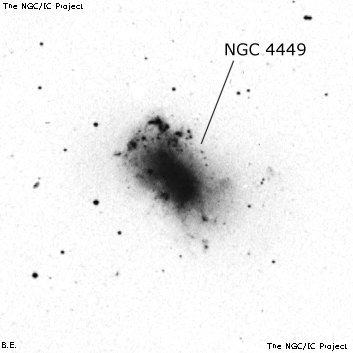NGC/IC Project Restoration Effort
(This is a very very beta version)
NGC4449


Basic Information
Location and Magnitude
Right Ascension: 12:28:11.3
Declination: +44:5:42
Constellation: CVN
Visual Magnitude: 9.6
Historic Information
Discoverer: Herschel W.
Year of discovery: 1788
Discovery aperture: 18.7
Observational
Summary description: vB, cL, mE, D or bifid, rrr, * 9 f 5'
Sub-type: IBm
Steve's Notes
=====
NGC 4449
48" (2/20/12): NGC 4449 is a boxy-shaped Magellanic-type Irregular containing several bright, giant HII regions that are sites of active star formation. The galaxy has been intensively studies as one of the strongest galaxy-wide starbursts in the nearby universe. The overall surface brightness of the galaxy was unusually high at 375x. The very bright central region is elongated SW-NE, irregular in surface brightness and contains a small, intense "nucleus" described as a ~10 Myr old super star cluster in the 2001 study "The Star Clusters in the Irregular Galaxy NGC 4449". To the southwest is a fairly large, bright patch that mimics a second core. This region is catalogued as #27/28/30 in Hodge-Kennicutt's 1983 "Atlas of HII regions in 125 galaxies" [HK83]. Several patches are on the north end of the galaxy. The largest and brightest is #15, a high surface brightness irregular glow at the north end of the galaxy, 20"x12", with a mottled surface and a stellar knot (#11) at the north tip. Roughly 35" SW is #25, a moderately bright roundish knot of ~12" diameter. At the northeast tip of the galaxy is #2, nearly 1' SE of #15. It appeared as a moderately bright knot, ~15"-20" in size. A small knot (#16) was noted on the southeast side of the galaxy. A mag 14 star is superimposed [44" ENE of the nucleus]. Member of the M94 Group (CVn I Cloud).
18" (5/14/07): very mottled, irregular appearance, elongated ~2:1 SW-NE, ~5'x2.5'. The core is quite splotchy in appearance with a couple of bright knots; the most prominent is attached to the southwest of the core. The main body is roughly rectangular with an extension at the northwest "corner" that ends with a bright knot or knots ([HK83] #15). Another extension or knot ([HK83] #2) is off the northeast corner. A mag 13 star lies 2.4' E of the core and 1 or 2 additional very faint stars or knots are superimposed in the central region.
18" (5/8/04): fascinating view of this "Magellanic" system at 323x! The galaxy is very irregular in appearance and surface brightness with a large, bright, elongated core oriented SW-NE. The core appears offset to the south side of the galaxy.
Several knots (giant HII regions) are visible outside the core. The brightest is a well-defined obvious patch on the north edge of the galaxy, 1.5' from the center. This object is #15 in Hodge-Kennicutt's 1983 "Atlas of HII regions in 125 galaxies" ([HK83]) and it is nearly comparable in surface brightness to the core. Roughly 1' SE is #2, a smaller, faint knot that is collinear with #15 and a mag 13.5 star 2.4' E of the core. #25, a third difficult knot, can sometimes be glimpsed about 40" SW of #15. Finally, attached on the south end of the core is a larger, bright knot, although initially I thought this was just part of the core.
13.1" (4/12/86): very bright, very large, elongated SW-NE, bright core, stellar nucleus. A knot is involved at the north end and the galaxy generally appears brighter to the north of the core. A star is superimposed close east of the core.
8": bright, moderately large, elongated, bright core.



